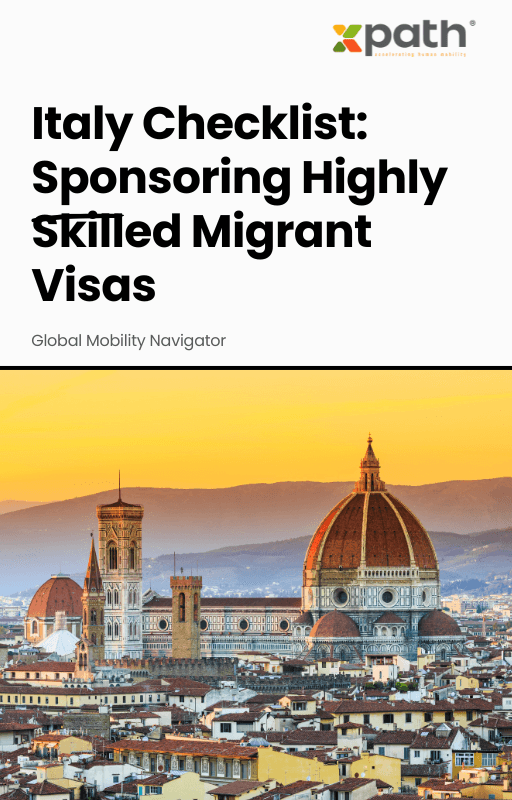Italy Checklist: Sponsoring Highly Skilled Migrant Visas
Grab a copy of a guide to international employee relocation
View E-bookRemember the days when “going to work” meant commuting to a single office day in and day out? The workplace has changed, and so has the meaning of employment location. Thanks to a surge in remote and mobile work arrangements, businesses now find themselves managing teams scattered across state lines, each jurisdiction armed with its own tax rules. Overlooking these complexities can cost companies more than they bargained for. So, how can organizations ensure seamless state-level tax compliance for remote and mobile workers—without losing their minds or burning a hole in their budgets? Let’s break it down.
With 35% of workers in the United States now working remotely full- or part-time (according to a 2024 Gallup poll), the old rules of tax withholding and reporting have gone out the window. Hybrid and mobile workforces are the new standard. Some employees might spend Mondays in Massachusetts, Wednesdays in New York, and Fridays working from a coffee shop in Colorado. Each work location brings its own set of tax implications—state income tax, unemployment insurance, and beyond.
What’s fueling this change? Flexibility, global talent pools, and technology. But these perks come with strings attached, especially if your payroll or HR teams haven’t updated their playbooks on multi-state or even multi-country tax compliance.
What’s the catch? Each U.S. state operates a different set of tax laws around employee income, withholding, and reporting. Twenty-four states impose their own income taxes, while others like Texas and Florida do not. If your team member lives in one state and works in another—even just a few days a year—you could be on the hook for withholding and remitting taxes in both states.
This gets even more complicated with “convenience of the employer” rules. New York, for example, taxes income earned remotely as if the work were performed in-state, unless it’s for the employer’s necessity. Keeping track of who works where, when, and why is now critical.
According to the American Payroll Association’s 2023 survey, 72% of companies reported compliance challenges tied to mobile or remote workers. A Forbes analysis found that almost half of surveyed employers inadvertently under-withheld state taxes last year, risking fines and audits. States are beefing up enforcement—for revenue recovery and fairness to local taxpayers. In 2023 alone, California and New Jersey ramped up efforts to track out-of-state remote workers and recoup revenue lost to “work from anywhere” trends.
Case in point: In 2022, one large fintech firm was fined over $100,000 for failing to properly withhold taxes for employees working part-time in different states. Their error? Relying on outdated data and failing to track employee mobility. That’s a hard lesson—and a red flag for companies still playing by old rules.
Managing state tax compliance isn’t just about forms and paychecks. It involves:
For HR, finance, and payroll teams already juggling a thousand tasks, compliance can feel like a game of Whac-A-Mole. Even well-established organizations can be caught off guard by a routine audit or a minor employee location change.
If manual checklists won’t cut it anymore, what will? The answer lies in tech-enabled global mobility solutions—a lifeline in the tangled world of tax regulation. Platforms like xpath.global are revolutionizing how businesses handle employee location tracking, policy management, and multi-jurisdictional compliance.
With agile dashboards, automated alerts, and a network of expert partners, these solutions give HR and payroll teams “x-ray vision” into who’s working where, when, and for how long. They can automate reporting, manage cross-border submissions, and flag any compliance risk before it balloons into a problem. For organizations scaling across state or national lines, these tools are becoming as essential as project management suites or cloud-based accounting systems.
There’s no magic wand, but there are tried-and-true steps any business can take:
First, update your employee onboarding to capture the intended work location. Educate your workforce on how their location impacts taxes and benefits—not just for transparency but to foster a culture of compliance.
Second, invest in technology that provides location tracking, real-time tax law updates, and compliance reporting. Consider a scalable mobility solution like xpath.global to empower your HR and payroll teams with actionable insights.
Finally, consult with multi-state payroll and legal experts regularly. The landscape is changing quickly, and a second pair of eyes never hurts—especially when the stakes are high.
State-level tax compliance isn’t just a box to check. It’s a make-or-break factor in employee experience and business risk management. As remote and mobile work become the norm, the winners will be companies that put compliance at the heart of their mobility strategy—empowered by technology and expert support. Don’t wait for an audit to realize the importance. Plan, act, and stay ahead.
What is state-level tax compliance for remote workers?
It refers to following each state’s unique payroll tax, withholding, and reporting rules when employees live or work outside the company’s home base.
How can I keep up with changing state tax laws?
Subscribe to tax update bulletins, partner with a global mobility platform like xpath.global, and schedule regular legal reviews.
Does working from another state for a few days trigger compliance issues?
Potentially, yes. Some states require tax withholding for even a day’s presence. Always verify each state’s rules for temporary or transient work.
Why is technology important for state tax compliance?
Managing compliance manually is risky and inefficient. Modern platforms automate location tracking, reporting, and law updates—saving time and reducing audit risks.
Can platforms like xpath.global help with both US and international compliance?
Absolutely. xpath.global provides end-to-end mobility solutions and local expertise for both US state-level and cross-border HR tax compliance challenges.
Ready to transform your mobility program? Explore xpath.global’s solutions.

Italy Checklist: Sponsoring Highly Skilled Migrant Visas
Grab a copy of a guide to international employee relocation
View E-book